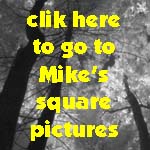This page contains fundamental camera
repair/tune up information applicable to all kinds of cameras
Recently, I found that my
old Minolta SRT's meter and shutter speeds were not quite right. After
some investigation, I have found that simple tune up and repair
techniques for this type of old camera were not too hard for a tinkerer
like myself. I found it necessary to construct a shutter tester and a
light source for testing meters. Much of what I
have learned is available for you to explore on my "SRT Tune Up" page.
Here are some
things I've learned about fixing up an old Rolleicord V TLR camera.
Here are some things I've learned about
fixing up a couple of old Canonet cameras.
Here are notes on repairing the
two most common faults of the Stereo Realist.
Here are some tips I will offer on scanning with the Minolta Dual II
film scanner.
Picture Galleries
I have acquired these pictures over the last 40
years. Some I have taken myself, some were taken by friends or family.
I am not foolish enough to think that there are any award winning
pictures here, but perhaps some of them will be interesting enough that
you will not feel that I have wasted your time.
(Click on thumbnails to go to the
gallery of your choice)
Mike's
Photography Philosophy
I like old
mechanical cameras. I like the challenge of setting the exposure and
aperture based on the readings of a simple meter and manual focusing to
get just the right result. The gear is a lot less expensive than the
new high end gear. The results can often be superior to that
of modern automatic cameras. Note that when it comes to fast action
or candid type shots, I'm usually very challenged. I have also
have had some fun repairing old mechanical cameras.
I take my SRT SLR system
along with me in a fanny pack made by Lowe Pro, called the Orion. This
bag works very well for taking along a SLR, a couple of lenses and a
flash. It is easy to work out of. However, in the final analysis, this
is too much stuff to carry on the waist and I often hang it from my
shoulder. I think I might end up buying a traditional shoulder bag,
which should be much more comfortable to carry on longer hikes. I might
find that there is application for both types of bags.
I have one 35-105mm zoom for my manual
Minolta system. Turns
out it is great for those times when you can't carry more than one lens
on vacation or whatever. Last summer I took my Minolta with
this
zoom and my Rolleicord on a long week to Colorado and it turned out to
be a fine combination. When I can carry more than one lens or
am
close to home, I rarely use it.
I recently picked up a Canonet 17 for portability and
convenience. I carry it when I don't have any particular plans to take
pictures, but the opportunity for a nice shot could crop up.
It takes nice, but not great pictures. For a while
I was looking into replacing it with a Rollei 35 or other small, but
high quality 35mm camera, but for now I'll live with the Canonet.
I got a great
deal on an old Rolleicord V towards the end of
a local camera show. It is lots of fun to work with and takes wonderful
pictures. I mostly shoot black and white and am currently
experimenting
with filters. I have also found that with Kodak Portra 160
NC, exposed
at ASA 125 the 'cord has produced some good results. Even in
full
sun the Porta NC, has the latitude to handle the contrast like a
champion.
I have to admit I've perhaps doubled my investment in used
Rollei products by buying closeup lenses, hoods and filters on Ebay for
it. As time
goes on, I use this camera more and more when I'm out to get that great
shot,
especially in the outdoors. I've also used it for infrared
and got
some shots that I'm really proud of. I usually take it when I
go on
vacation and think I'll have a little time for photography.
I purchased a nice Stereo Realist off of Ebay. It
needed a small bit
of work to get into top shape, but it has been a blast to play with.
Stereo
pictures from this 50 year old gem will simply amaze most advanced 21st
century
tech geeks. There is simply nothing like it in the mainstream
marketplace.
I consider it a little marvel.
I'm still using
film as my primary picture acquisition method - mostly slide film,
sometimes negative film. I am moving more towards slides since they
seem to be much easier to store in an organized fashion than negatives.
I have been using the storage boxes made by a company called Logan. You
can keep hundreds of slides in a single small suitcase style metal box.
Also, if
it is well done, people still enjoy the occasional old fashioned slide
show.
I have 3 digital cameras. The first is a inexpensive Agfa 307
with fixed focus and only 640x480 resolution. Not really
useful,
even for web pictures. A digital camcorder with still capture
mode.
Slightly better than the Agfa, but not much.
Finally, a 2MP
Cannon A60. The shutter lag, when attempting taking pictures
of moving
targets, is pretty brutal. It supports manual mode, but the
ergonomics
are simply awful compared to my Minolta SLRs. The picture
quality
is fine for web use. I did find was that for small
still life
objects, it appears that the macro mode, combined with the instant
digital
feedback, is a huge win. Many of the recent additions to
this website
have been documented, with this camera. One other thing
- compared
side by side with scans of film, the lack of grain in the digital shots
is
astounding. Keep in mind that this is not always for the
good, since
a plain flat surface looks very flat and lacks any texture.
This is
not always pleasing.
When the need presents itself, I use a film scanner to get
the negatives into a Macintosh, which is used as a digital darkroom.
Only a small percentage of the photographs I have or take end up in
digital format. I use either Photoshop Elements or Photoshop
5.0 LE for digital manipulation. Turns out that 5.0 supports
limited color correction on 16 bit files, which is useful as a first
step for
work that is especially important to me.
I take pictures when I feel
like it. After all, it's a hobby. If it is too hard to do, I'll
probably leave it for someone else to try. I have no interest in making
any money in photography. My regular job is hard enough, I don't want
any additional stress. The favorite pictures that i have
taken are mostly environmental portraits
of family or friends or landscapes.
I don't want to spend a whole lot of
money on photography. I'll probably tire of it and go on to something
else in a couple of years. Note the other hobby activities on my page
that I'm not currently engaged in. Oh, I'll probably continue to dabble
in all these activities from
time to time, but who knows.
I don't want to struggle with inferior equipment that makes
enjoying the hobby too difficult.
 Tune Up
Page
Tune Up
Page  Fix It Page
Fix It Page  Fix It Page
Fix It Page  et Fix It Page
et Fix It Page
 et Fix It Page
et Fix It Page
 Fix It Page
Fix It Page
 Fix It Page
Fix It Page
 Scanner Tips Page
Scanner Tips Page 



